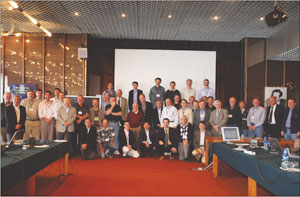JINR, Dubna, was host to the latest in the general meetings of the Global Design Effort (GDE) for a future International Linear Collider (ILC). The workshop on ILC Conventional Facilities and Siting (CFS) took place between 4–7 June 2008. It provided the opportunity for GDE members to take a look at the potential site near Dubna, first proposed in 2006.
The meeting focused on issues surrounding conventional facilities, such as water cooling and other cost drivers, which in turn depend on the eventual siting of a high-energy linear collider. (The conventional facilities account for about a third of the total estimated cost.) Parallel sessions at the workshop aimed at understanding the potential impact on the cost of various solutions, both for the current ILC Reference Design and alternative scenarios. The workshop also included discussions of CFS issues for a Compact Linear Collider, to try and identify common cost-effective solutions for both machines.

Image credit: JINR.
In preparing the reference design report issued in 2007, the GDE considered a deep site, about 100 m below ground. To proceed with the reference design, the GDE had asked the regional subgroups for “sample sites” in the three regions: the Americas, Asia and Europe; all three were deep. By contrast, the proposal submitted for the GDE’s consideration by Grigory Shirkov, ILC project leader and chief engineer at JINR, is for a shallow site, requiring the construction of only one tunnel instead of two. This plan, which resulted from the joint discussions between JINR and the State Specialized Design Institute in Moscow, has a tunnel 20 m below ground in a thick layer of dry soil (loam). The collider infrastructure can be installed at or near the surface, avoiding the need for a second service tunnel. The region is seismically stable within almost 50 km of the site proposed for the collider and is practically uninhabited. The participants of the meeting had a chance to look at the suggested area from a helicopter, offered by the governor of the Moscow region, Boris Gromov.
While at Dubna, GDE members also met with representatives of the Russian State Project Institute, Moscow, which has a long history of designing and constructing nuclear power stations, nuclear centres and scientific accelerator centres, including those at JINR and at the Institute for High Energy Physics in Protvino. Discussions are now under way on work towards more detailed studies, including drilling a 1.6 m borehole near the proposed location of the interaction region. In addition to the Dubna site, the GDE plans to study other possible shallow sites, for example in a desert, and to study further the engineering options in deep sites, with a view to minimizing costs.
Further reading
• For more about the Dubna site, see www.linearcollider.org/cms/?pid=1000548.







